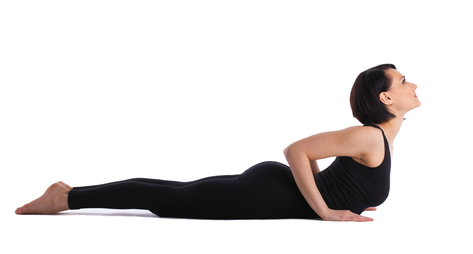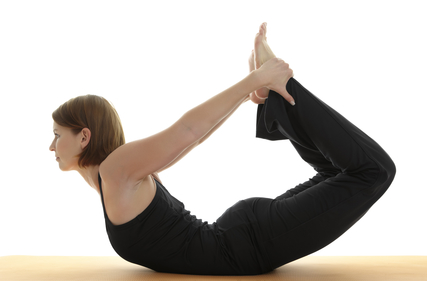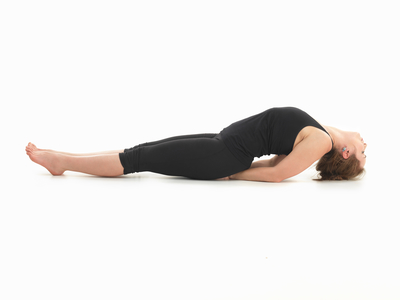Se-tu Ban-dhaa-sa-na Setu = bridge; bandha =
lock
Instructions
Place a folded blanket on the floor and lie
on the blanket in savasana, with the tops of your shoulders
2-3 inches below the folded edge of the blanket, arms directly
alongside your body on the blanket.
Bend your knees and slide your feet in, about
4-6 inches from your buttocks. Keep your feet hip-width apart
throughout this pose. Firmly tuck your pelvis and, on an
inhalation, press the balls of your feet into the floor and
slowly lift your spine off the floor, one vertebra at a time.
Come up as far as is comfortable. Bring your palms together
behind your back and interlace your fingers. Roll your
shoulders under, one side at a time, opening your chest
without closing off the back of your body.
To complete the pose, release your hands and
grasp your ankles. Your shins should be vertical; if your
knees are farther from your head than are your ankles, then
either press up farther into the pose (pelvis firmly tucked)
or release your ankles, step your feet away from your head,
and interlace the fingers once again.
Breathe smoothly and naturally as you hold
the pose. Mentally affirm, "I offer every thought as a bridge
to divine grace."
To exit, inhale and tuck your pelvis, then
exhale and slowly lower your spine back to the floor, one
vertebra at a time.
Pause in savasana and integrate the effects of the pose. Or
if your lower back needs a release, proceed immediately to a
counterpose (e.g., hug your knees to your chest and roll side
to side).
Bhujangasana

Cobra Pose
"I rise joyfully to meet each new
opportunity."
Bhu-jan-gaa-sa-na Bhujanga = serpent, snake
Instructions
Assume a prone position with your forehead on the floor and
feet hip-width apart (or less). Place your palms on the floor
beside your chest, elbows close at your sides. Gently lengthen
back through your legs during the entire pose.
On an inhalation, curl your torso off the floor in three
stages: First use your neck muscles to lift your head (and
only your head) as far as possible (without jackknifing your
neck). Then use your upper back muscles to lift your chest as
far as possible. Finally, press the pubis into the floor and
use your lower back to lift you up as far as possible (but
without lifting the navel from the floor).
Use your arms to provide stability and support, but not to
push yourself up into the pose. Keep your elbows in at your
sides, shoulders relaxed away from your ears, and shoulder
blades spread wide. Gaze softly upward, keeping the back of
your neck long.
Breathe smoothly and naturally as you hold the pose, and
affirm mentally, "I rise joyfully to meet each new
opportunity."
To exit, inhale and lengthen your spine; on the exhalation
release your torso slowly back to the floor.
Pause in the prone position and integrate the effects of
the pose. Or, if your lower back needs a release, proceed
immediately to a counterpose (e.g., balasana).
Dhanurasana

Bow Pose
"I recall my scattered forces to recharge my
spine."
Dha-nur-aa-sa-na Dhanu = bow
Instructions
Begin in the prone position with your forehead on the
floor. Bend your knees, keeping them hip-width apart, and
grasp the outsides of your ankles. Keep the pubis in contact
with the floor throughout this pose to protect your lower
back.
Inhaling, press the pubis into the floor, lift your legs
off the floor, and begin to move your feet away from your
head, drawing your upper body off the floor. As your body
comes into a bow shape, keep your shoulder blades spread wide,
knees hip-width apart, and pubis on the floor. Actively
lengthen the entire underside of your body, with the tops of
your thighs lengthening toward your knees, and your
stomach/chest area lengthening toward your chin.
Breathe smoothly and naturally as you hold the pose and
affirm mentally, "I recall my scattered forces to recharge my
spine."
To exit, inhale and lengthen your spine, then on the
exhalation lower your legs and torso slowly back to the floor.
Let go of your ankles and lie in the prone position.
Pause to integrate the effects of the pose. Or, if your
lower back needs a release, proceed immediately to a
counterpose (e.g., balasana).
Matsyasana

Fish Pose
"My soul/loots on waves of cosmic
light."
Mat-syaa-sa-na Matsya = fish
Instructions
From savasana, place your hands underneath your sitbones
arms straight, elbows shoulder-width apart (not under the
body), and palms down. On an inhalation, press your elbows
into the floor and your sitbones into your hands, lifting your
upper body into a backward bend. If your head comes off the
floor, soften your neck into the same curvature as the rest of
your spine and gently lower the crown of your head to the
floor. (Place only as much weight on the crown of your head as
if you were standing upright, resting a hand on top of your
head.)
Continue pressing your elbows into the floor and sitbones
into your hands to maintain a dynamic backward bend of your
spine. Open the chest and front of neck.
Breathe smoothly and naturally as you hold the pose and
affirm mentally, "My soul floats on waves of cosmic
light."
To exit, inhale and press your elbows into the floor,
bringing the crown of your head off the floor and your chin
toward your chest, lengthening the back of your neck. Then
exhale and slowly remove the support of your elbows, gently
lowering yourself back into savasana, starting with your
lumbar spine and finishing with your head.
Pause to integrate the effects of the pose.
Salabhasana
Locust Pose
"I
soar upward on wings of joy!"
Sa-la-bhaa-sa-na Salabha = locust
Instructions
Assume the prone position, arms down at your sides and chin
to the floor. Pressing the pubis firmly into the floor, inhale
and lift your legs, arms, and torso off the floor into a
backward bend, using the strength of your legs, shoulders, and
lower back. Turn your palms toward your body and lengthen your
fingers toward your feet. To protect your lower back, keep
actively pressing the pubis into the floor and lengthening
through your legs. Keep the back of your neck long.
Breathe smoothly and naturally as you hold the pose,
mentally affirming, "I soar upward on wings of joy!"
To exit, inhale and lengthen your entire body, then exhale
and release back into the prone position.
Pause in the prone position and integrate the effects of
the pose. Or, if your lower back needs a release, proceed
immediately to a counterpose (e.g.,
balasana).